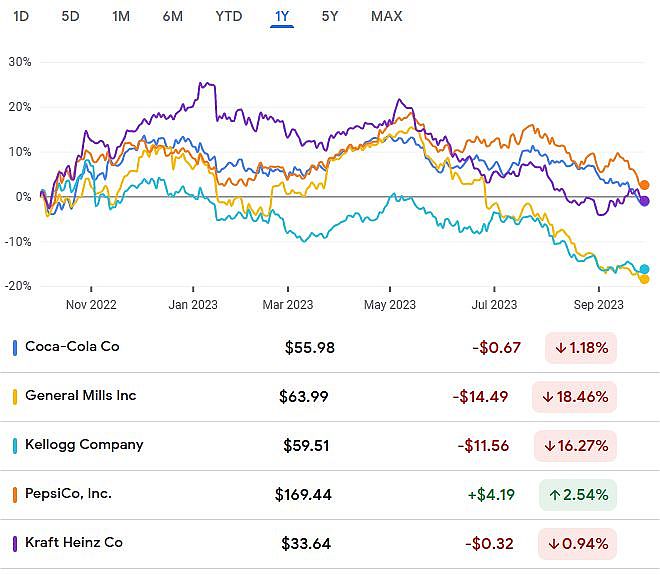In recent weeks, stock indexes have fallen by large percentages, paring a large part of their year-to-date gains. Stock markets are pressured by a prospect of “higher for longer” interest rates, weighing on technology shares, which have been at the forefront of market gains this year. Meanwhile, flagging economic indicators suggest that some level of economic weakness is to be expected in the months ahead.
At the same time, consumers are beginning to feel the pinch of higher energy and shelter costs, as well as the increase in prices of various services; the price squeeze portends lower consumer activity going forward. All in all, it seems that stocks are entering a period of much higher volatility, driven by economic uncertainty.
In these difficult times, investors tend to turn to classic havens, such as consumer staples – stocks that tend to do relatively well during economic downturns, since they belong to firms selling necessities such as food and beverages, something no one can do without.
The Comfort Food
As we watch the stubborn inflation, pay much more at the pump, and brace for a potential economic downturn or even recession, many investors begin to recalibrate their portfolios to decrease risk and volatility with the aim of shielding their capital. That’s where safe-haven stocks come into the light.
The traditional safe-haven assets, used by investors for decades during market turbulence to limit losses, have been the U.S. dollar, Treasuries, gold, cash, and defensive stocks. From the point of view of stock investing, the classic defense strategy has been buying stocks of companies that sell basic necessities – things that we all consume or use on a daily basis, regardless of the economy or the state of the market. These include utilities, health products, basic home supplies, and food.
These defensive companies typically maintain stable earnings in different stages of the economic cycle. U.S. consumers, on average, spend 25% of their income on staples like food, beverages, and personal products; these necessities are the stickiest part of the consumer basket. As a result, defensive companies display predictable revenue streams and long-term stability in earnings. In harsh economic environment, many companies in cyclical industries struggle to maintain profitability or even stay in business altogether, while defensive companies are resilient, and can even use the downturn to their advantage (such as buyouts of struggling rivals).
That’s why stocks of companies engaged in these spheres usually retain their value, or fall much less than the broad market, during times of market decline. On the flip side, in times of a stock market rally, these stocks cannot match the gains displayed by more volatile high-growth companies.
The Sweet Recompense
Defensive companies tend to compensate their investors for the lack of high-growth prospects through dividends. As the companies in defensive industries tend to be stable, large, and mature, they don’t have to invest in growth as much as others, which leaves them with a lot of money to share with their shareholders.
Statistically, dividend-paying stocks tend to decline much less than the broad market during a downturn, since the dividend income feature of the defensives is especially enticing at a time when stocks decline in value, or when inflation eats into the value of capital and savings.
Moreover, there is a strong correlation between dividends and the companies’ financial health. Only companies with consistently robust profitability and strong free cash flows can afford to maintain, let alone grow, their dividend payouts over a long period. That’s why the stocks of long-term dividend growers are always in demand.
In a high-interest rate and high-inflation environment, dividends become the most important feature of the defensiveness of a stock. While most defensive shares provide a cushion against declines in stock prices by declining less, their conservative price appreciation over the long term doesn’t supply enough compensation for the value lost to inflation. Meanwhile, high interest rates make other, broadly safe, assets – like government bonds or money market funds – more appealing; to beat this appeal, stocks must offer a “bonus” in the form of a dividend.
While defensive stocks generally underperform the broad market rallies, according to research, dividend-paying companies that have consistently increased their payouts over time have outperformed the S&P 500 while showing lower volatility. As Warren Buffett famously said, “In the short run, the market is a voting machine, but in the long run, it is a weighing machine,” meaning that in the long term, fundamentals matter the most.
However, one doesn’t have to patiently wait for decades to see the appeal of the dividend payers. According to Bloomberg data, “Dividend Aristocrats,” i.e., companies that have constantly grown their cash dividends for at least 25 consecutive years, have seen their earnings increase by an average of 10% year-on-year in Q2 2023, while other companies’ profits shrunk.
Wide Supply, Narrow Choice
When it comes to consumer goods, individual investors tend to prefer “household names,” brands they instantly recognize. Although there are over 400 of these brands, their ownership is concentrated within just a few massive corporations. While it may not be the best layout for market competition, which is supposed to bring down prices for consumers, it definitely makes life easier for investors.
Following decades of consolidations through mergers and acquisitions, virtually all of the U.S. consumer staples’ market share is held by eleven consumer conglomerates: Coca-Cola (KO), General Mills (GIS), Johnson & Johnson (JNJ), Kellogg’s (K), Kraft Heinz (KHC), Mondelez (MDLZ), Nestlé (NSRGY), PepsiCo (PEP), Procter & Gamble (PG), and Unilever (UL). Another major player is Mars, Inc., the only privately held company in the list of grocery and personal goods giants. All of these names, apart from Johnson & Johnson and Procter & Gamble, sell food and beverage products (and more).
All these companies display a wide economic moat, helping them wield their pricing power over consumers, and enormous scale, enabling them to lower their costs and maintain healthy margins. Their global reach and wide product portfolios make each of them a significant investment portfolio diversifier.
Moreover, these giants offer dividend yields ranging from 2.2% (Mondelez) to 4.6% (Kraft Heinz) – versus the S&P 500’s (SPX) average yield of 1.6%. Most of these consumer stalwarts have been growing their payouts through thick and thin times for many years. Some of them are even included in the list of “Dividend Aristocrats,” i.e., companies that have constantly grown their cash dividends for at least 25 consecutive years. The consumer-staple aristocracy includes Procter & Gamble, Coca-Cola, and PepsiCo.
Food for Thought, at the Right Price
As we can see, the grocery and personal goods conglomerates check the “fundamentals” and the “dividends” boxes; but what about the valuations?
Consumer staples surged in 2022 on the back of recession fears as the Federal Reserve embarked on its path of sharp monetary tightening. However, as the economy has proven itself much more resilient than was feared, and as the optimism about technology stocks prevailed, consumer staple stocks flagged. The Consumer Staples Select Sector SPDR Fund (XLP) has been flat in the past 12 months, versus the S&P 500’s 16% gain. The staples ETF has tumbled by 11% from its recent peak in May, while the wide market was helped up by the AI rally and general tech outperformance.

Source: Google Finance
As a result, many of the consumer staple companies are trading below their historical valuations. Notably, while Consumer Staples as a group typically trades at lower P/E ratios than other industries, the eleven consumer conglomerates have never been cheap, and for a good reason. But after recent declines, many of them present a better case for value play than before. For instance, Coca-Cola is now trading at par with the sector median P/E, which is a 12% discount to its 5-year average. General Mills, Kraft Heinz, and Unilever are now trading at a discount to both their sector’s average and their own historical averages. Nestlé, Mondelez, PepsiCo, and Kellogg are still expensive compared to the Consumer Staples sector, but their price-to-earnings ratios have come down significantly in recent months, and now look very reasonable, considering their fundamentals and dividend growth.
To conclude, consumer staple stocks as a whole, and food stocks in particular, may provide much-needed portfolio insulation in market setbacks, while delivering steady and reliable income, helping investors weather the economic downturns.
















